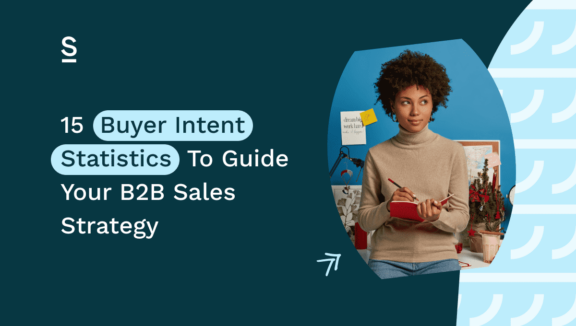15 Buyer Intent Statistics To Guide Your B2B Sales Strategy

Only 2-5% of any market is actively seeking to buy at any given time. Buyer intent is the phase of the buyer’s journey when a potential customer has shifted from researching, to being ready to buy. It’s when they’re most likely to purchase your product and is the moment any sales strategy is ultimately leading to.
Understanding buyer intent is crucial to sales success, so we’ve compiled some of the most interesting stats on buyer intent which can help you better understand your audience, and might even change your approach to sales.
The data in this article comes from the following sources: RollWorks & Bombora, DemandScience, Harvard Business Review, Gartner.
Key Buyer Intent Stats:
- 73% of B2B marketers report that they are already using, or planning to use buyer intent data in the year ahead
- 50% of leaders said intent data helps with sales and marketing alignment
- Over 25% of businesses are using buyer intent data to deliver ads and campaigns to companies with a high engagement potential
- 56% of survey respondents are using buyer intent data primarily to identify new accounts to target
- 50% of sales leaders use intent data to improve account prioritization
- 97% of B2Bs believe that using intent data provides a competitive advantage this year
Buyer Intent Statistics That Should Shape Your B2B Sales Strategy:
1. Two-thirds of B2B’s report using a combination of both first-party and third-party data
Layering first-party data (engagement data from your own digital assets) with data from other providers (data showing behaviors and signals outside of your owned properties) can create a comprehensive picture of a buyer’s needs, including whether there is buyer intent.
First party is often down-funnel engagement on websites/owned properties when a lot of the buyer research is completed. You can see which pages and blogs on your site are most popular, showing you what kinds of content is resonating with interested potential customers.
Third party data helps you examine behaviors before they get to your website, making it possible to get a foot in the door earlier, raising the potential for you to help the buying group throughout their vetting and research process.
This kind of data can shorten the time it takes a customer to reach buyer intent, and sales teams should gather and analyze as much data as they can to help potential customers make the right decision once they’re ready to buy.
2. Market research firm Ascend2 reports that 97% of B2B marketers believe that third-party intent data can give brands a competitive advantage
Intent data can be used to better understand opportunities, and move them through the buyer’s journey.
Third party data can be useful in setting up your ideal customer profile (ICP).
3. 73% of B2B marketers report that they are already using, or planning to use intent data in the year ahead
As mentioned, intent data can help you understand your customers on a deeper level. Understanding what brought them to you, what pages on your website they’ve looked at, and for how long, can help shape your approach when it comes to engaging with them.
The majority of B2B marketing and sales people are already using buyer intent data in their strategies. If you aren’t, it can help refine your sales strategy on multiple levels, from the earliest stages of the buyer’s journey all the way up to the purchasing decision.
4. 50% of leaders said intent data helps with sales and marketing alignment
Once you have buyer intent data, it can be incredibly useful for both your marketing team and your sales team. Because both teams will be working with the same data, it helps to bring them into alignment, and can form the basis for a closer working relationship across multiple areas and campaigns.
This data will be vital in both sales and marketing efforts, so with both teams working from the same point of understanding there should be less conflict or miscommunication, more collaboration, and more cohesion when it comes to achieving objectives.
5. Customers are, on average, 37% of the way through a purchase process by the time they reach the solution-definition stage, and 57% of the way through the process before they engage with supplier sales reps
This highlights that your B2B sales approach might be too late by the time a sales rep gets in touch with the potential customer. Intent data can help signal the crucial moment where a salesperson should get in touch, and enable you to impact the buyer’s experience during the solution-definition stage, meaning you’re more likely to get a conversion.
6. Over 25% of businesses are using purchase intent data to deliver ads and campaigns to companies with a high engagement potential
Advertising is one of the most powerful tools in sales, and intent data lets you focus your efforts and budget on the people who are most likely to convert. Furthermore, if your data is accurate, you can target businesses who have the highest potential spend, meaning you only need a few conversions to massively increase your ROI and overall turnover.
7. 56% of survey respondents are using buyer intent data primarily to identify new accounts to target
Sales growth is a key metric for any business, and intent data lets you find new accounts instead of relying on your existing pool of clients. Once you’ve landed a new client, you can begin to develop the relationship, and hopefully bring in more business further down the line.
8. 50% of sales leaders use intent data to improve account prioritization
Once you’ve grown your customer base thanks to buyer intent, you suddenly have a lot of accounts to deal with, and it can be difficult to figure out who to prioritize. Again, intent data helps here, as it lets you analyze and understand exactly who is ready to purchase, and gives you an order of who to engage with first.
Those ready to purchase should be your immediate priority, while those who need additional information can be nurtured down the funnel over time.
9. One third (33%) of B2B’s would define the success of their intent data strategy as “best-in-class” compared to the competition. 63% of respondents define their success as “somewhat successful”. Only 4% said “unsuccessful”.
This shows that using buyer intent data is almost entirely successful for B2B sales. Even if it isn’t implemented particularly well, as is likely the case for businesses that try to adopt an intent data strategy without proper understanding, it can still make a positive impact on sales.
For businesses that take the time to implement a robust intent data strategy, the results are revolutionary, changing how the business operates.
10. For 56% of B2Bs, data quality is among the top challenges when using intent signals
It’s easy to get a lot of data. There are hundreds or even thousands of data points along any business’ buyer journey, and just your website alone can provide a staggering amount of data, before you factor in email, social media, and additional third party data.
The problem isn’t quantity, it’s quality. What parts are useful? What can be actioned? What helps improve efficiency, and what causes a headache?
When it comes to buyer intent data in sales, only the data that can be consistently linked to sales and KPIs should be analyzed. Does this data point move someone down the funnel? Is it a positive signifier, like web page dwell time, or social engagement? If it isn’t, you likely don’t need to worry about it.
Once you’ve outlined the most important sets of data for your sales funnel, you can focus on ensuring that data is as high quality as possible.
11. 97% of B2Bs believe that using intent data provides a competitive advantage this year
Once your intent data is analyzed, and providing actionable insights, you can use it to start getting ahead of your competitors. This can range from how you get in touch with your customers, to how you structure information on your website, to which keywords your ads are built around.
All of these points of information can help increase conversion rates, build brand awareness, or improve customers relations, in ways you wouldn’t be able to without that intent data.
12. 55% of sales leaders saw an increase in lead conversions when using intent data
When you’ve made improvements and gotten ahead of your competitors thanks to your data, you’ll naturally see an increase in your conversion rate thanks to an optimized sales journey.
Increasing your lead conversion rate is one of the best ways to improve your overall sales efficiency.
13. Intent data is used by over 40% of B2B sales leaders to enrich their CRM
It’s important to remember that data needs to be stored, updated, and used, not just filed away and forgotten. Keeping your CRM up to date with buyer intent signals can help you better predict when other customers will arrive at the intent phase.
You can further enrich your CRM by keeping your records and contacts up to date by importing data directly from LinkedIn with Surfe.
14. 48% of B2B leaders say that intent is a core part of their revenue strategy
As we’ve seen, buyer intent can help bring in new business, and increase conversion rates, so it’s not surprising that many B2B leaders see it as a core part of their sales strategy.
It makes sense to build your business around your buyers’ intentions, laying the groundwork for the moment they’re ready to purchase. If you fully understand the intent of your audience, you can make the purchase decision simple, easy, and painless, making it more likely that they’ll purchase from you again in the future.
15. More than 70% of B2Bs can be expected to utilize third-party intent data to target buyers
Because of how much buyer intent can impact conversion rates, the vast majority of B2Bs are using intent data to target potential customers.
Given how much of the research phase is done online, there is a wealth of data out there that can give you much-needed insights into how your audience thinks, what actions they take, what websites they visit, and how long it takes them to move from one phase of the buyer’s journey to the next. All of these insights can help shape your sales strategy, and are already being taken advantage of by many of the top sales teams around the world.
Let’s wrap it up!
These statistics show that buyer intent data can massively impact a sales strategy for the better, helping to increase conversion rates, bring in new customers, and prioritize existing accounts.

Bring all your data to LinkedIn
View contact data and deals on LinkedIn. Automatically sync sales actions and conversations with your CRM.
FAQ about Buyer Intent in B2B Sales:
What is buyer intent in sales?
Buyer intent is when a potential customer shifts into the decision-making phase. They’re ready to make a purchase, and so you need to make sure that purchase is your product.
What signals buyer intent?
You can tell there is buyer intent when potential customers provide a phone number or email when they make contact on your website. Data from bottom-of-funnel pages like product comparisons and testimonial pages.
How can you increase buyer intent?
Focus on showcasing your product’s best features and benefits. The more concrete product information you provide, the better informed your customer is to make a purchasing decision.
You can use social proof to build trust, with testimonials and case studies. These show potential customers that you’re the right choice.
You can create urgency with a limited time deal, sale, or free trial period. This encourages potential customers to sign up now, instead of waiting around until they’ve done more research.


